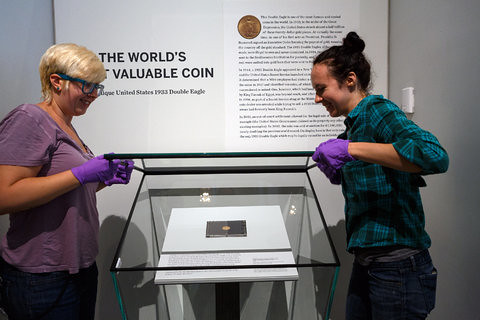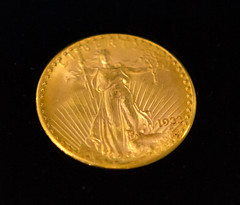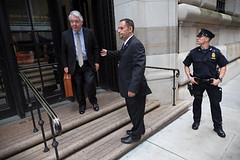
PREV ARTICLE
NEXT ARTICLE
FULL ISSUE
PREV FULL ISSUE
1933 DOUBLE EAGLE MOVES UPTOWN TO NEW-YORK HISTORICAL SOCIETY
"Movin' on up... To the (West) Side..." On Monday the New York Times reported on the journey of the privately-owned 1933 Double Eagle from the New York Federal Reserve vault uptown to the New-York Historical Society, where it's going on display for the public. It's great to see the piece going on display again, and interesting because of recent E-Sylum articles discussing security for the transport of ultra-rare coins, and that unusual hyphen in the name of the NYHS (or should that be the N-YHS)?
-Editor
On Monday, a man in a dark suit stashed the coin in his briefcase and coolly walked out of the Fed’s heavily guarded limestone-and-sandstone building, a couple of blocks from the New York Stock Exchange in Lower Manhattan. He nodded politely to the guards on the front steps of the Fed. They did not stop him.
“It’s history,” Louise Mirrer, the president of the historical society, said of the coin after Mr. Redden had turned it over to curators who fitted it into a display case. “We have lots of priceless objects, but it’s always exciting to have the most valuable anything.” The coin is valuable — Mr. Redden auctioned it at Sotheby’s for $7,590,020 in 2002, at the time the highest price any coin has ever sold for — because it should not exist. That is why it has inspired four books, a documentary for the Smithsonian Channel and an episode of the cable-television drama “The Closer.” Known to coin collectors as a double eagle because it was worth twice as much as a $10 eagle gold piece, it was struck in 1933, the year in which President Franklin D. Roosevelt took the United States off the gold standard. He also ordered that year’s run of $20 pieces destroyed, except for two that were earmarked for the Smithsonian Institution. The double eagle that Mr. Redden put in his briefcase somehow escaped that fate. It apparently made its way to Egypt and back, and was seized by the Secret Service in a sting operation at the Waldorf-Astoria hotel in 1996. “For collectors,” he said as the S.U.V. barreled up the West Side Highway, “it’s almost a mystical experience to look at it.” He said this while looking at an almost identical double eagle, one from 1923 that did not have to be destroyed because it had been in circulation. He carries that coin with him everywhere, the way other people carry their cellphones. (He has one of those, too.) One element of the back story, he said, is the current owner, who has never been identified. “It’s one of the wonderful mysteries of coin collecting, who bought that coin,” Mr. Roach said. Mr. Redden described the owner as “a fabulous collector who was completely captivated by the story of the coin,” but not a coin collector. “After he bought it, he said, ‘I don’t want to take it home, I don’t want to put it in a bank vault — what should I do with it?’” Mr. Redden recalled. “I said the Fed is planning a show. It was the star of that show for years.” But last fall, the Fed sent the coin off to the vault. “The owner is interested in letting the public see it,” Mr. Redden said. The historical society beckoned, and the two security men followed Mr. Redden from the S.U.V. through the society’s back door. They watched as exhibition designers polished its case and tested the alarm, just in case.

“I don’t know what the threat level on this particular item is, because if they steal it, who’s going to buy it?” one of the security men, Louis Guiliano, said. “If you can’t fence the coin, it’s not valuable. It’s only valuable if you can get someone to pay you.” To read the complete article, see: A Coin Is Historic, Priceless and No Longer in a Vault (cityroom.blogs.nytimes.com/2013/08/12/a-coin-is-historic-priceless-and-no-longer-in-a-vault/)
To read some earlier E-Sylum articles, see:
THE BOOK BAZARREWayne Homren, Editor The Numismatic Bibliomania Society is a non-profit organization promoting numismatic literature. See our web site at coinbooks.org. To submit items for publication in The E-Sylum, write to the Editor at this address: whomren@gmail.com To subscribe go to: https://my.binhost.com/lists/listinfo/esylum All Rights Reserved. NBS Home Page Contact the NBS webmaster 
|

